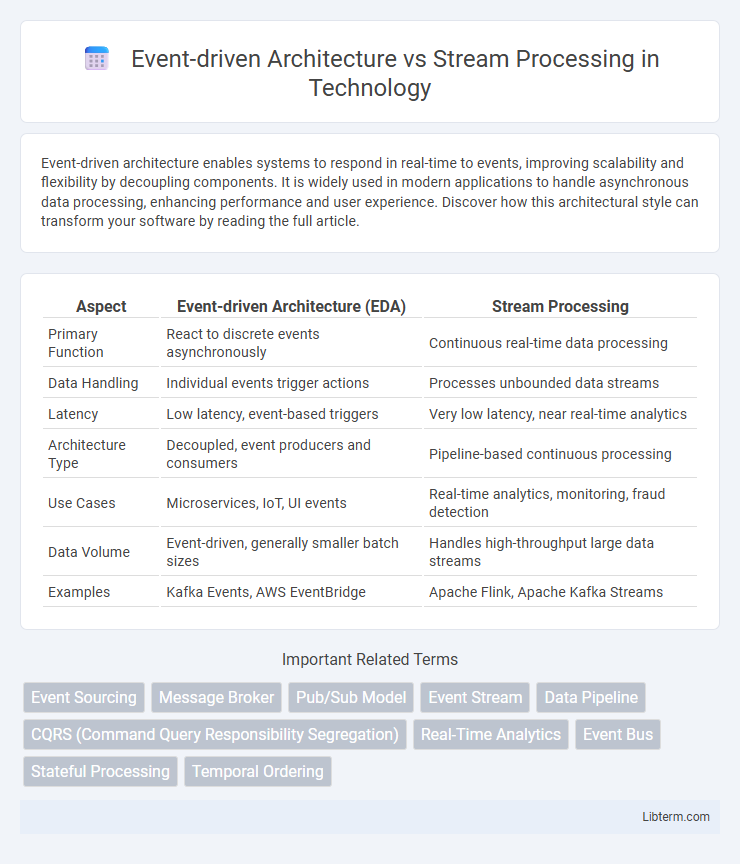Event-driven architecture enables systems to respond in real-time to events, improving scalability and flexibility by decoupling components. It is widely used in modern applications to handle asynchronous data processing, enhancing performance and user experience. Discover how this architectural style can transform your software by reading the full article.
Table of Comparison
| Aspect | Event-driven Architecture (EDA) | Stream Processing |
|---|---|---|
| Primary Function | React to discrete events asynchronously | Continuous real-time data processing |
| Data Handling | Individual events trigger actions | Processes unbounded data streams |
| Latency | Low latency, event-based triggers | Very low latency, near real-time analytics |
| Architecture Type | Decoupled, event producers and consumers | Pipeline-based continuous processing |
| Use Cases | Microservices, IoT, UI events | Real-time analytics, monitoring, fraud detection |
| Data Volume | Event-driven, generally smaller batch sizes | Handles high-throughput large data streams |
| Examples | Kafka Events, AWS EventBridge | Apache Flink, Apache Kafka Streams |
Introduction to Event-Driven Architecture
Event-Driven Architecture (EDA) is a software design paradigm that uses events as the primary means of communication between decoupled components, enabling asynchronous and scalable systems. Events represent significant state changes or actions, triggering real-time responses without direct calls between services. This architecture enhances flexibility, fault tolerance, and responsiveness, making it ideal for dynamic and distributed applications.
What Is Stream Processing?
Stream processing refers to the real-time analysis and processing of continuous data streams, enabling immediate insights and actions from high-velocity data sources such as IoT devices, social media feeds, and transaction logs. It operates on data in motion, allowing organizations to detect patterns, anomalies, and trends without the latency of batch processing. Stream processing frameworks like Apache Kafka, Apache Flink, and Apache Spark Streaming facilitate scalable, fault-tolerant handling of event data to power event-driven architecture applications.
Core Principles of Event-Driven Systems
Event-driven architecture centers on services communicating through events, enabling loose coupling and asynchronous interactions that improve scalability and responsiveness. Core principles include event production, event detection, event consumption, and event propagation, ensuring systems react promptly to state changes. Stream processing complements this by continuously analyzing event streams in real-time, facilitating immediate data-driven decisions within event-driven frameworks.
Key Features of Stream Processing
Stream processing handles continuous data flows in real-time, enabling immediate analysis and reaction to high-velocity information. Key features include low-latency processing, fault tolerance, scalability, and event-time processing for accurate time-based computations. Unlike event-driven architecture, stream processing focuses on real-time data pipeline orchestration and complex event pattern detection across distributed systems.
Event-Driven Architecture: Use Cases
Event-driven architecture (EDA) excels in scenarios requiring real-time responsiveness and decoupled system components, such as IoT applications, financial transaction monitoring, and online gaming platforms. Its event producers and consumers interact asynchronously, enabling scalable and flexible communication across distributed systems. EDA is particularly effective for implementing microservices, where independent services process events autonomously, improving fault tolerance and system agility.
Stream Processing: Real-World Applications
Stream processing enables real-time data analytics by continuously ingesting and analyzing high-volume event streams from sources like IoT devices, financial transactions, and social media feeds. It is widely applied in fraud detection systems, dynamic pricing models, and predictive maintenance in manufacturing, offering instant insights for rapid decision-making. Platforms such as Apache Kafka, Apache Flink, and Amazon Kinesis power these real-world applications by providing scalable and fault-tolerant data processing capabilities.
Architectural Differences: Event-Driven vs Stream Processing
Event-driven architecture centers on discrete events triggering specific actions or workflows, emphasizing asynchronous communication and loosely coupled components. Stream processing continuously ingests, analyzes, and processes real-time data streams, focusing on low-latency computations across large volumes of data. While event-driven systems react to individual events, stream processing systems operate on unbounded data flows for continuous insights and analytics.
Pros and Cons of Event-Driven Architecture
Event-driven architecture (EDA) offers high scalability and real-time responsiveness by decoupling producers and consumers, enabling systems to react promptly to events. However, EDA can introduce complexity in event management, debugging, and ensuring data consistency across distributed components. Despite potential challenges in event ordering and system monitoring, its flexibility supports dynamic workflows and asynchronous communication patterns effectively.
Advantages and Challenges of Stream Processing
Stream processing offers real-time data analysis by continuously ingesting and processing high volumes of data streams, which enhances decision-making speed and operational efficiency. It enables event-driven architecture to handle complex event patterns and detect anomalies promptly, benefiting industries such as finance, telecommunications, and IoT. Challenges include managing data consistency, scaling stateful computations, and ensuring fault tolerance while minimizing latency in distributed stream processing frameworks.
Choosing Between Event-Driven Architecture and Stream Processing
Choosing between event-driven architecture and stream processing depends on the application's real-time data requirements and complexity. Event-driven architecture excels in decoupling services for asynchronous event handling, ideal for microservices and user interactions. Stream processing optimizes continuous data flows and complex event pattern detection, making it better suited for analytics, monitoring, and real-time data transformation.
Event-driven Architecture Infographic

 libterm.com
libterm.com